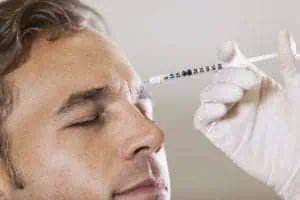 Men may pretend they don’t care about looking older, but the number of men getting Botox — or “Brotox,” if you like — to erase forehead creases and other wrinkles suggests otherwise. In fact, that number totaled more than 450,000 in 2018, according to the American Society of Plastic Surgeons.
Men may pretend they don’t care about looking older, but the number of men getting Botox — or “Brotox,” if you like — to erase forehead creases and other wrinkles suggests otherwise. In fact, that number totaled more than 450,000 in 2018, according to the American Society of Plastic Surgeons.
“Men want to look refreshed,” said advanced aesthetic medicine expert Bebe Pajo, MD, of Water’s Edge Dermatology. While some guys aspire to look younger in order to “stay in the game” at work, Dr. Pajo says most of her male Botox patients, who typically range in age from 40 to 70, seek these wrinkle-reducing injections in hopes of matching their partners’ more-youthful appearance.
“It bothers some of these men to look older than their wives, especially when they have younger partners,” said Dr. Pajo.
Women still get Botox injections far more often than men, but more men are following suit. In 2018, doctors performed 7,437,378 injections of Botox or another brand of botulinum toxin type A. While just 6% of those injections were given to men, that’s a 381% increase from 2000.
What is Brotox?
Brotox is simply a man-friendly nickname for Botox. They are the same thing (just as a “man bun” is the same as a bun, but on a man).
When injected into a muscle associated with skin wrinkles, Botox and similar products block nerve signals that tell the muscle to contract. This reduces the activity of the muscle. If you can’t furrow your brow as hard, the wrinkles on your forehead and the “elevens” — those vertical frown lines between the eyebrows — will soon begin to fade. (Don’t worry, you’ll still be able to move those muscles.) Botox can also be used to treat crow’s feet (wrinkles etched in the corner of the eye).
The only difference when men get Botox injections is that more Botox is typically required. “Most men have very strong muscle groups in their face, so they need more product than women to achieve the desired appearance,” said Dr. Pajo.
Why Botox?
Other cosmetic treatments, such as dermal fillers, can also help turn back the clock, but according to Dr. Pajo, men tend to prefer Botox because they don’t want to look like they had “work done.”
[su_quote]Men just want a natural appearance and tone, with younger-looking skin. To them, it’s about matching their physical appearance with how they feel on the inside.
[/su_quote]
The treatments are no-fuss: They typically take 10 to 15 minutes, and there’s no downtime afterward.
Botox results
Some Botox patients see results within a day or two. In most cases, wrinkles are reduced or eliminated within a week.
“My male patients are very happy with the treatment,” said Dr. Pajo. “They tell me their coworkers say things like, ‘You look refreshed and young. What’s new?'” When the treatment wears off, typically after about three to four months, their friends and colleagues notice a difference. “People ask them, ‘Are you stressed out? Sad? Is something bothering you?'”
Another potential benefit: Several studies suggest Botox can boost self-esteem in men and women. Scientists are still studying the reason, but Dr. Pajo said it’s no surprise, in part because facial expressions appear to have a direct impact on mood. The act of frowning may contribute to sadness, while the act of smiling may contribute to happiness.
“When you have a happy muscle expression, it sends signals to your brain that you’re happy,” Dr. Pajo said. Plus, she noted, “If you look at yourself in the mirror and you look amazing, you feel good.”
Botox side effects
Any side effects from Botox injections are typically mild. You may have some pain, tenderness, swelling or bruising. An infection is possible, but unlikely.
After the procedure, Dr. Pajo recommends exercising the treated muscles by scowling or smiling to help ensure the entire muscle group is exposed to the Botox. She advises patients not to lie down or lean forward (even to type a text) for four hours following the procedure so the Botox doesn’t migrate away from the treatment site. Patients who take certain medications and supplements, such as ibuprofen, blood thinners and multivitamins, may experience pinpoint bruising at the injection sites, though Dr. Pajo said this side effect is rare and fades quickly.
Article Written By: Timothy Gower, an award-winning journalist who writes about medicine and health. His work has appeared in more than two dozen national magazines.
Medical Review By: Bebe Pajo, MD





